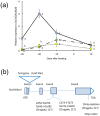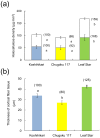Increased lodging resistance in long-culm, low-lignin gh2 rice for improved feed and bioenergy production
- PMID: 25298209
- PMCID: PMC4190510
- DOI: 10.1038/srep06567
Increased lodging resistance in long-culm, low-lignin gh2 rice for improved feed and bioenergy production
Abstract
Lignin modification has been a breeding target for the improvements of forage digestibility and energy yields in forage and bioenergy crops, but decreased lignin levels are often accompanied by reduced lodging resistance. The rice mutant gold hull and internode2 (gh2) has been identified to be lignin deficient. GH2 has been mapped to the short arm of chromosome 2 and encodes cinnamyl-alcohol dehydrogenase (CAD). We developed a long-culm variety, 'Leaf Star', with superior lodging resistance and a gh phenotype similar to one of its parents, 'Chugoku 117'. The gh loci in Leaf Star and Chugoku 117 were localized to the same region of chromosome 2 as the gh2 mutant. Leaf Star had culms with low lignin concentrations due to a natural mutation in OsCAD2 that was not present in Chugoku 117. However, this variety had high culm strength due to its strong, thick culms. Additionally, this variety had a thick layer of cortical fiber tissue with well-developed secondary cell walls. Our results suggest that rice can be improved for forage and bioenergy production by combining superior lodging resistance, which can be obtained by introducing thick and stiff culm traits, with low lignin concentrations, which can be obtained using the gh2 variety.
Figures







Similar articles
-
Nitrogen fertilizer application affects lodging resistance by altering secondary cell wall synthesis in japonica rice (Oryza sativa).J Plant Res. 2017 Sep;130(5):859-871. doi: 10.1007/s10265-017-0943-3. Epub 2017 Apr 27. J Plant Res. 2017. PMID: 28451936
-
Engineering the lodging resistance mechanism of post-Green Revolution rice to meet future demands.Proc Jpn Acad Ser B Phys Biol Sci. 2017;93(4):220-233. doi: 10.2183/pjab.93.014. Proc Jpn Acad Ser B Phys Biol Sci. 2017. PMID: 28413198 Free PMC article. Review.
-
GOLD HULL AND INTERNODE2 encodes a primarily multifunctional cinnamyl-alcohol dehydrogenase in rice.Plant Physiol. 2006 Mar;140(3):972-83. doi: 10.1104/pp.105.073007. Epub 2006 Jan 27. Plant Physiol. 2006. PMID: 16443696 Free PMC article.
-
Landraces of temperate japonica rice have superior alleles for improving culm strength associated with lodging resistance.Sci Rep. 2020 Nov 16;10(1):19855. doi: 10.1038/s41598-020-76949-8. Sci Rep. 2020. PMID: 33199753 Free PMC article.
-
Genetic modification of plant cell walls to enhance biomass yield and biofuel production in bioenergy crops.Biotechnol Adv. 2016 Sep-Oct;34(5):997-1017. doi: 10.1016/j.biotechadv.2016.06.001. Epub 2016 Jun 3. Biotechnol Adv. 2016. PMID: 27269671 Review.
Cited by
-
Jasmonic acid contributes to rice resistance against Magnaporthe oryzae.BMC Plant Biol. 2022 Dec 20;22(1):601. doi: 10.1186/s12870-022-03948-4. BMC Plant Biol. 2022. PMID: 36539712 Free PMC article.
-
Nitrogen fertilizer application affects lodging resistance by altering secondary cell wall synthesis in japonica rice (Oryza sativa).J Plant Res. 2017 Sep;130(5):859-871. doi: 10.1007/s10265-017-0943-3. Epub 2017 Apr 27. J Plant Res. 2017. PMID: 28451936
-
Engineering the lodging resistance mechanism of post-Green Revolution rice to meet future demands.Proc Jpn Acad Ser B Phys Biol Sci. 2017;93(4):220-233. doi: 10.2183/pjab.93.014. Proc Jpn Acad Ser B Phys Biol Sci. 2017. PMID: 28413198 Free PMC article. Review.
-
Phytolith Formation in Plants: From Soil to Cell.Plants (Basel). 2019 Jul 26;8(8):249. doi: 10.3390/plants8080249. Plants (Basel). 2019. PMID: 31357485 Free PMC article. Review.
-
Optimization of Nitrogen Rate and Planting Density for Improving Yield, Nitrogen Use Efficiency, and Lodging Resistance in Oilseed Rape.Front Plant Sci. 2017 May 9;8:532. doi: 10.3389/fpls.2017.00532. eCollection 2017. Front Plant Sci. 2017. PMID: 28536581 Free PMC article.
References
-
- Chen F. & Dixon R. A. Lignin modification improves fermentable sugar yields for biofuel production. Nat. Biotech. 25, 759–761 (2007). - PubMed
-
- Jorgensen L. R. Brown midrib in maize and its linkage relations. J. Am. Soc. Agron. 23, 549–557 (1931).
-
- Li X., Weng J. K. & Chapple C. Improvement of biomass through lignin modification. Plant J. 54, 569–581 (2008a). - PubMed
-
- Oliver A. L., Pedersen J. F., Grant R. J. & Klopfenstein T. J. Comparative effects of the sorghum bmr-6 and bmr-12 genes: Forage sorghum yield and quality. Crop Sci. 45, 2234–2239 (2005).
Publication types
MeSH terms
Substances
LinkOut - more resources
Full Text Sources
Other Literature Sources
Miscellaneous

